Part 2 – 2004 – Mostly MIGMATE
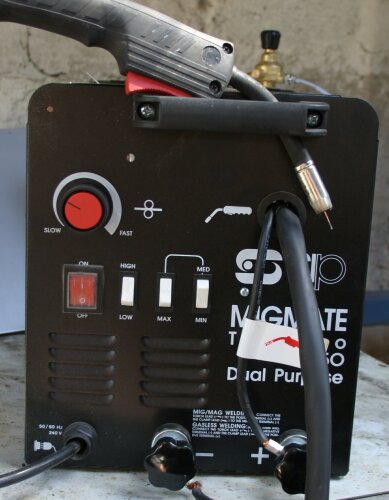
In progress – Almost done.
To Page 1
These
MIG pages have become quite popular since I started to update them
a few months ago (late 2004). They aren't quite finished but I
don't think I'll do much more to them for quite a while. When I
do, there will probably be a page or two on the projects I have
been using the welder for – nothing flash but something
real.
My MIG page has been one of my most popular pages despite being somewhat out of date. Until a few weeks ago I had done no MIG welding to speak of since 1999. My share in the WIA150 was bought to weld Aluminum for my chainsaw mill. Late 1999 I started full time work again, I also had a major theft of tools and I stopped doing my slab timber stuff.
The WIA is at Phil's place 90 minutes drive from here. I've never brought it home – just seems too much hassle – it is heavy and clumsy with bottle and all. I decided to buy a baby MIG that I could have on hand whenever I needed it. The main anticipated use was 1.5mm steel – that is furniture steel and steel framing for building. A small gas-less MIG (now AKA MOG) would probably do the job. I have a stick welder for heavier work and the WIA for gas work. I took a look at one sold be super-cheap auto (an Australian Auto chain which sells cheap imported tools). Aus $400 bought a 95Amp MOG which looked like crap. Bunnings (Ozzie hardware chain) had CIGweld MOG for the same money which looked a bit better but the CIGweld 135Amp MIG (around au$700) seemed better value. I waited and the price went up au$100 (and came down again after I bought something else). I UMM'd and RRR'd a bit and thought maybe I would go up in power and was looking for a 165Amp Cigweld.
 In
my travels on broadband I found a UK add for disposable gas
bottles. These seemed like a good idea to me, BOC are charging
$100 a year rental for gas bottles. This might be ok to a heavy
user but for the rare bit of MIGging I do it would work out
cheaper to use the little ones – particularly if I wanted a
variety of gases. I was expecting to buy a conventional MIG with
regs for big bottles etc and then try to get an adapter for the
disposable ones. I remembered seeing little CO2 bottles at
“Glenfords” (Ozzie tool store chain) but I wasn't sure
what they were for at the time. Recently I've started working more
with steel and had use for a MIG.
In
my travels on broadband I found a UK add for disposable gas
bottles. These seemed like a good idea to me, BOC are charging
$100 a year rental for gas bottles. This might be ok to a heavy
user but for the rare bit of MIGging I do it would work out
cheaper to use the little ones – particularly if I wanted a
variety of gases. I was expecting to buy a conventional MIG with
regs for big bottles etc and then try to get an adapter for the
disposable ones. I remembered seeing little CO2 bottles at
“Glenfords” (Ozzie tool store chain) but I wasn't sure
what they were for at the time. Recently I've started working more
with steel and had use for a MIG.
So I went to see what Glenfords had.... The pile of gas bottles was exactly what I'd hoped for CO2, CO2/argon and pure argon. I didn't notice any tri-mix (argon/O2/He) or argon/O2 but maybe I didn't dig enough. They were all Au$30 – a little dearer than I had hoped but still affordable.
Then
over to the welders and checked out a MIGMATE 150. The welder was
there to look at but no box , no specs and no price. I looked
inside and then asked the guy at the counter. He was nice enough
and dug up a catalog which some very basic specs. It “seemed”
ok – I noted it only went up to .8mm wire but I could live
with that. What wasn't obvious (maybe it was there but I missed
it) was the pathetic duty cycle. The duty-cycle 20% at 95 Amps –
so what is it at 150Amps?? Not much.
It takes both mini-reels
and 5Kg spools and uses the little bottles as standard.
The
Package was the welder, one bottle of argon/co2 mix, regulator,
one mini-spool of gas less wire (not full weight ie a sample), one
mini-spool of steel wire plus a face shield and wire brush. The
price was AU $600 – I bought it along with extra gas
mixtures.
Gripes.
First the bad news. Let's get my gripes out
of the way.
The face-mask looks like it came out of a large
cereal packet – not a problem because I already have an
electronic one (a MUST).
The instructions are not great.
The
voltage selection (3 switches – 6 settings) are very
counter-intuitive – a simple lookup table would help.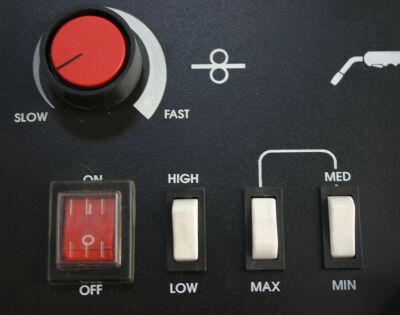
No
rubber feet.
No protection for the gas hose – when no
bottle is used the tube is left to dangle in the dirt.
Changing
between .6 and .8 require unscrewing two screws (screwed into
plastic) to reverse the roller – a knurled nut or something
would have been nicer.
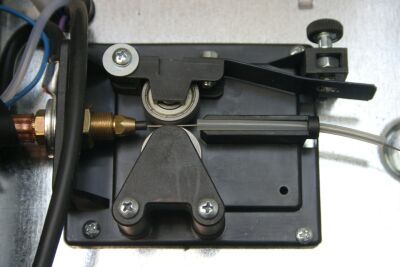
The steel wire was .6mm but no .6mm tip was supplied.
I have found some websites which say MigMate is crap. I'd say it depends on what you want to do with it and what you want to spend. I was prepared to spend more money but I wanted something light. I can pick up this MIG up with one hand and I have hung it from the roof a few time to weld roofing joists – I wouldn't want to do that with a heavy unit.
First Run.
The first thing I tried was welding 0.4mm
zinc-alum roofing iron and .6mm galvanized iron. This is much
thinner than recommended and not something I need to do. Using
.8mm MOG I could sometimes run a bead along it but mostly I made
holes. I could certainly tack weld it and this has some use. I
bought some .6mm tips and tried the same with CO2 MIG and .6mm
wire. I'm pretty sure I could weld it if I had better voltage
control. At the lowest voltage and feed rate I could run a bead OK
but it was a thick caterpillar looking thing with poor
penetration. Faster feed and it would start popping, the second
voltage step was to much. The voltage control is very crude.
In
these days of electronic everything you'd think they could do
better. For the low power settings a home brew power supply would
not be out of the question.
I also welded some 6mm gal weld mesh. I had welded square gal
washer onto mesh (to use as security screens on the shed) using my
stick welder. This was a slow process. I had to clamp the job
because the stick does want to stick. The weld rarely worked first
go and I'd have to chip/scrape the slag and run a second bead to
stick it all together – it probably took 5 to 10 minutes per
washer. With MOG I could hold the washer in place with my glove,
tack it in a few seconds and run a very strong looking weld around
in one go – maybe a minute to do and a much better job. Wire
to wire worked well to. I did not do as well with MIG. I think it
is because of the thin wire – I have now go some .8mm wire
but I've not tried it yet (nope that wasn't it -see
below).
Mostly I've been welding 1.5mm galvanized iron
using MOG. I've been fairly happy with the results. Some people
grind the galvanizing off before welding – I haven't. I
think the gal might make it a bit harder to get started but once
you are going the zinc burns away ahead of the weld. The
zinc-oxide cleans off more easily than the flux residue. The Gal
melts before it burns so it pays the let the job cool down before
brushing it if you want to avoid brushing the gal away. The flux
residue is not like the slag from a stick weld – it is
powdery and usually come off fairly easily using a wire brush. MOG
tends to throw little balls of molten metal about. I've managed to
start a few fires this way and yes they can burn you as well. With
MOG you definitely need to “pull” the gun along –
ie have the wire feeding towards the hot weld. If you push you
will spray burnt flux powder onto the area you are about to weld –
bad idea.
Economy.
I have not attempted to work it out properly
but I suspect MOG is the most economical way to weld at my level
of use. I would think that MIG with CO2 in large bottles and large
spools would be the most economical for big users and MIG using
disposable CO2 bottles best for infrequent use. This might sound
strange but you have to take into account MOG wire doesn't keep
well. It may vary from brand to brand but the old SIP MOG wire I
had was VERY rusty, I discarded maybe %10 of the roll and still
had a few patches of rust remaining. This is not good for the weld
because you loose the electrical contact as the rust goes through
the tip and I'm sure it must wear the tip as well.
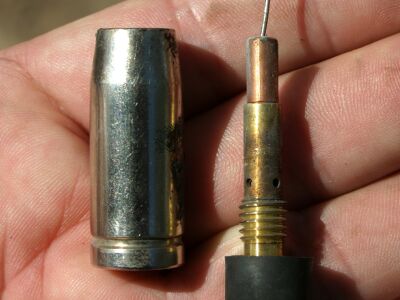 Tips
(copper).
Tips
(copper).
I had use maybe a bit over one mini-roll's worth
of wire when my welding went bad. It turned out to be the tip. I
was expecting them to last longer. It is possible cleaning the
inside of the hole might have given it some more life but I
haven't tried too hard. The MigMate uses M5 threaded tips. I tried
2 closer shops before ending back at Glendord's for a packet of
them. They were around Au$16 for 5 (I think) so it pushes the cost
of MOG welding up by %10 or so. I suspect MIG wire maybe less
abrasive to the tip than MOG. The fact that the .8mm drive roller
is knurled and impresses a pattern onto the surface of the wire
may also be a factor.
Months later. After my 3'rd tip I did clean one. I used
bleach and a piece of wire to get the muck out of the tip. I seems
to be working again. Pete from the UK emailed me to say
anti-splatter spray would fix my problems. Maybe, maybe not. After
much navel gazing I'd decided that the white muck which came out
of the tip is not flux residue but unused flux. When I examined
the flux cored wire under a microscope I found the wire isn't tube
like say a hose is it is metal wrapped into a tube with a seam
along the side. I think that under some circumstances (molten?)
flux is force out of the side of the wire before it leave the tip.
I not certain of this and I don't know if anti-splatter would help
or not. Next time I will try my newly purchased ultra sonic
cleaner. I'll probably try acid as well. I'll update this after
I've tried it.
MAG
test – I think I smell lemon.
First time round I
didn't have much success with MAG/MIG. I blamed it on the thin
wire. I bought .8 mm wire and tried again. I tried every possible
setting and could not get it to work. The feed speed seemed to
high even on the lowest setting. Increasing the voltage just made
to pops more energetic. I didn't fancy going back to the shop for
help so I took a guess that there would be a trim pot on the PCB
and indeed there was.
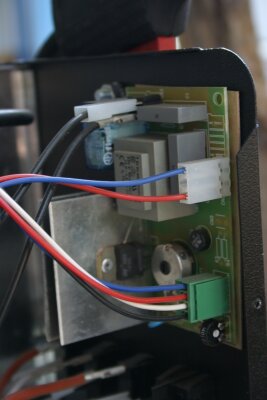 A
very touchy little bugger, it managed to slow the feed-rate down
and then I could stop the popping and run a weld. I'm not
impressed. There is nothing to the circuit and a fix may be
possible – changing the trim-pot to a multi-turn type would
be a step in the right direction. The results on the test welds
are below. The MAG results were not impressive enough to change
over from MOG to MAG. Now that it is set up I might use MAG a bit
just for practice.
A
very touchy little bugger, it managed to slow the feed-rate down
and then I could stop the popping and run a weld. I'm not
impressed. There is nothing to the circuit and a fix may be
possible – changing the trim-pot to a multi-turn type would
be a step in the right direction. The results on the test welds
are below. The MAG results were not impressive enough to change
over from MOG to MAG. Now that it is set up I might use MAG a bit
just for practice.
All the test weld are on 1.5mm wall 25mm
square tubing, some is galvanized some is painted. No surface prep
was done expect where noted. MAG needed much higher voltage
setting. For MOG on 1.5mm gal I've been using the two lowest
setting. With MAG I seem to need the top on the low range or the
bottom of the high range.
Next day.
I did a few more
samples. I tried to weld the acute end of the corner I did with 45
deg cuts. Something went wrong and I think it was the CO2 got
blown away by a draft. I also did one weld on a tube with the
paint sanded off – reasonable – and one with a little
bit of paint removed to get it started this turned out quite good
and is in the table of images below.
I also ground a couple of
the welds back to see how they look (one below).
(later) The
speed control problem has persisted and it really need fixing. I
have designed a few speed controllers in my day and I'm sure this
can be fixed or improved upon but it would take more time that it
is worth – unless I do it for “fun”. Later –
I think I fixed the problem.
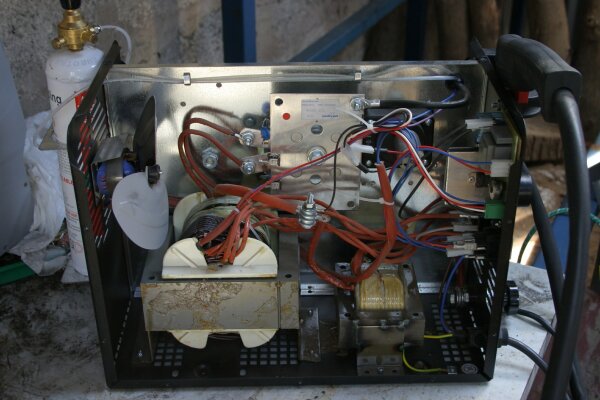
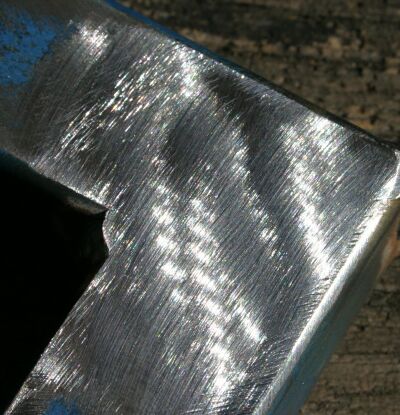
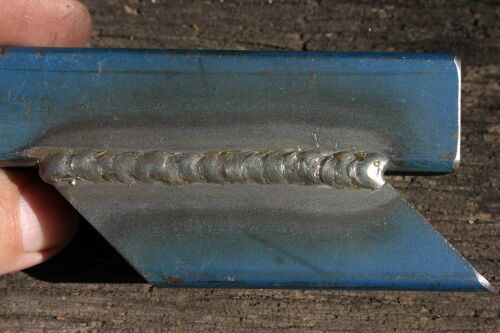 Would
I buy it again.
Would
I buy it again.